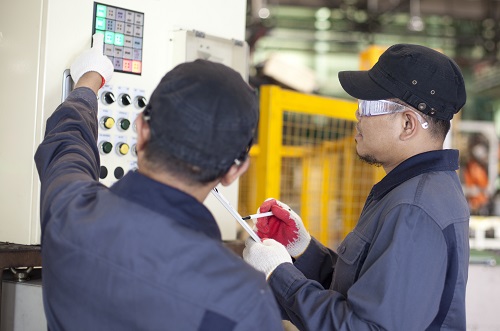Programmable Logic Controllers (PLCs) are critical components in industrial automation, serving as advanced control systems that manage and regulate various processes. Imagine a complex industrial setting where machinery, production lines, and other processes need precise and coordinated control – this is where PLC controls come into play.
PLC controls are the backbone of modern industrial automation, providing intelligent and reliable control in diverse industrial settings. Their flexibility allows for easy reprogramming, and adapting to changes in production requirements without the need for extensive manual adjustments.
Because Storee Construction has been around several generations of PLC tech, we’re comfortable working with legacy systems in and around whatever unique solution each facility has developed. Also, we are used to working with the facility expert on equipment with both integrated or external PLCs and automation and can customize our operation to ensure continued function.
What Are PLC Controls?
 PLC controls are used to automate tasks that were traditionally performed manually, saving time and providing efficiency, accuracy, and reliability in industrial operations. These electronic devices are programmed to execute specific instructions, monitor inputs and outputs from sensors, and make decisions based on pre-defined logic. They act as the brains of the operation, ensuring seamless coordination between different components of a system.
PLC controls are used to automate tasks that were traditionally performed manually, saving time and providing efficiency, accuracy, and reliability in industrial operations. These electronic devices are programmed to execute specific instructions, monitor inputs and outputs from sensors, and make decisions based on pre-defined logic. They act as the brains of the operation, ensuring seamless coordination between different components of a system.
In industrial situations, PLC controls find applications in a wide range of scenarios. They are used in manufacturing plants to control machinery on production lines, regulating processes such as assembly, packaging, and quality control. In facilities handling complex machinery or automated systems, PLCs ensure precise control over parameters like temperature, pressure, and speed.
They are integral in managing tasks such as motor control, and ensuring that equipment operates within specified parameters for optimal performance and safety. PLCs play a crucial role in minimizing human intervention in repetitive or hazardous tasks, enhancing the overall efficiency of industrial processes.
Where are PLC Controls Used?
These versatile devices are widely used in various industrial situations, providing automated control for a multitude of processes. In manufacturing, PLC controls are instrumental in regulating production lines. For instance, in an automotive assembly plant, PLCs manage robotic arms, conveyor belts, and other machinery, ensuring precise coordination in tasks such as welding, painting, and assembly.
In food processing industries, PLCs play a vital role in controlling the production and packaging of products. They monitor factors like temperature, pressure, and mixing ratios, ensuring consistency and quality. PLC controls are also employed in the pharmaceutical industry for the precise control of mixing, filling, and packaging processes to meet stringent quality standards.
PLCs are indispensable in handling complex machinery in material handling systems, controlling conveyor systems, robotic arms, and sorting mechanisms in distribution centers and warehouses. They sense when there are issues and can send alerts to crews on the floor via warning lights or sounds or to remote HMI (Human Machine Interface) locations hundreds of miles away.
Work With Industrial PLC Experts
In short, PLC controls are employed across diverse industries, from automotive and food processing to water treatment and energy production, showcasing their adaptability and efficiency in automating and managing intricate industrial processes.
However, proper installation and programming of industrial controls are required to take advantage of their many benefits. When you work with Storee Construction, we’ll find out exactly what you need from your plant and how PLCs can help. From there, our engineers get to work designing systems that improve production while maximizing safety for your employees, facilities, and customers.
